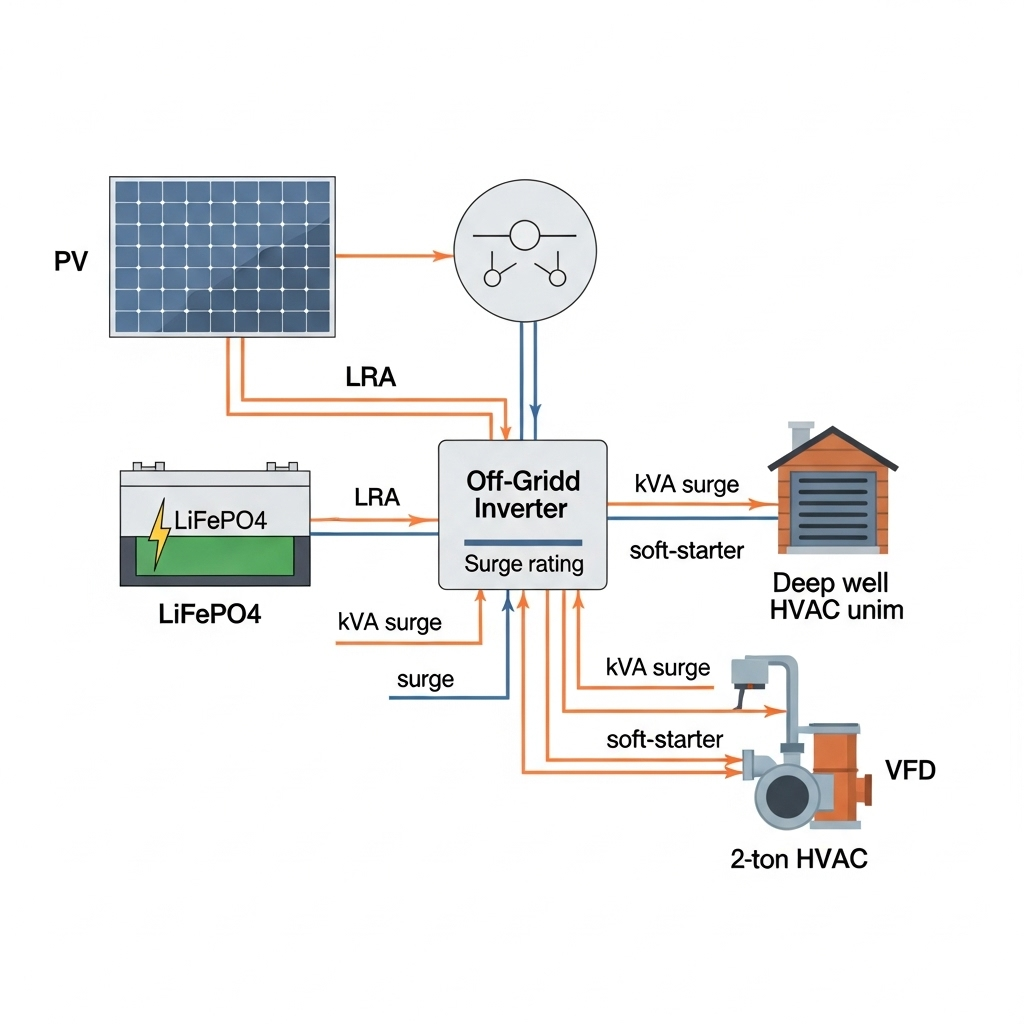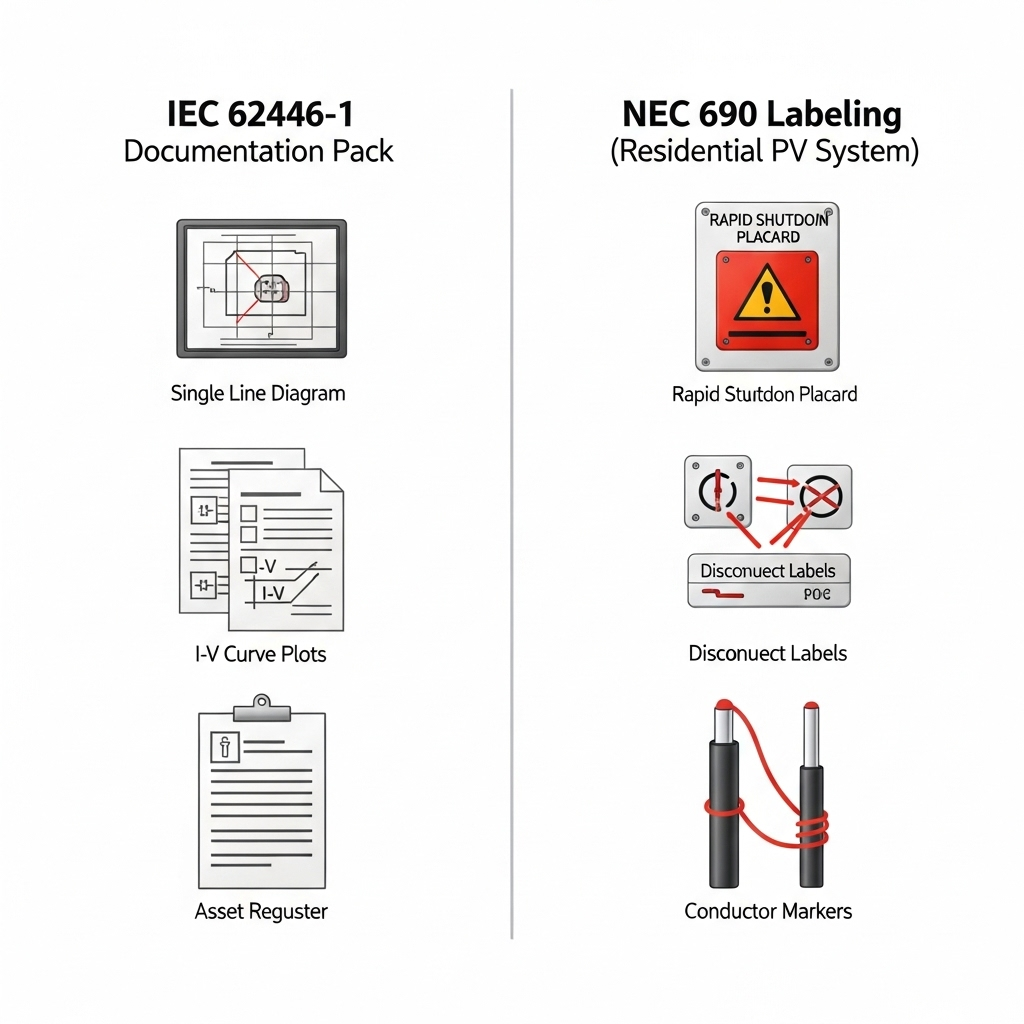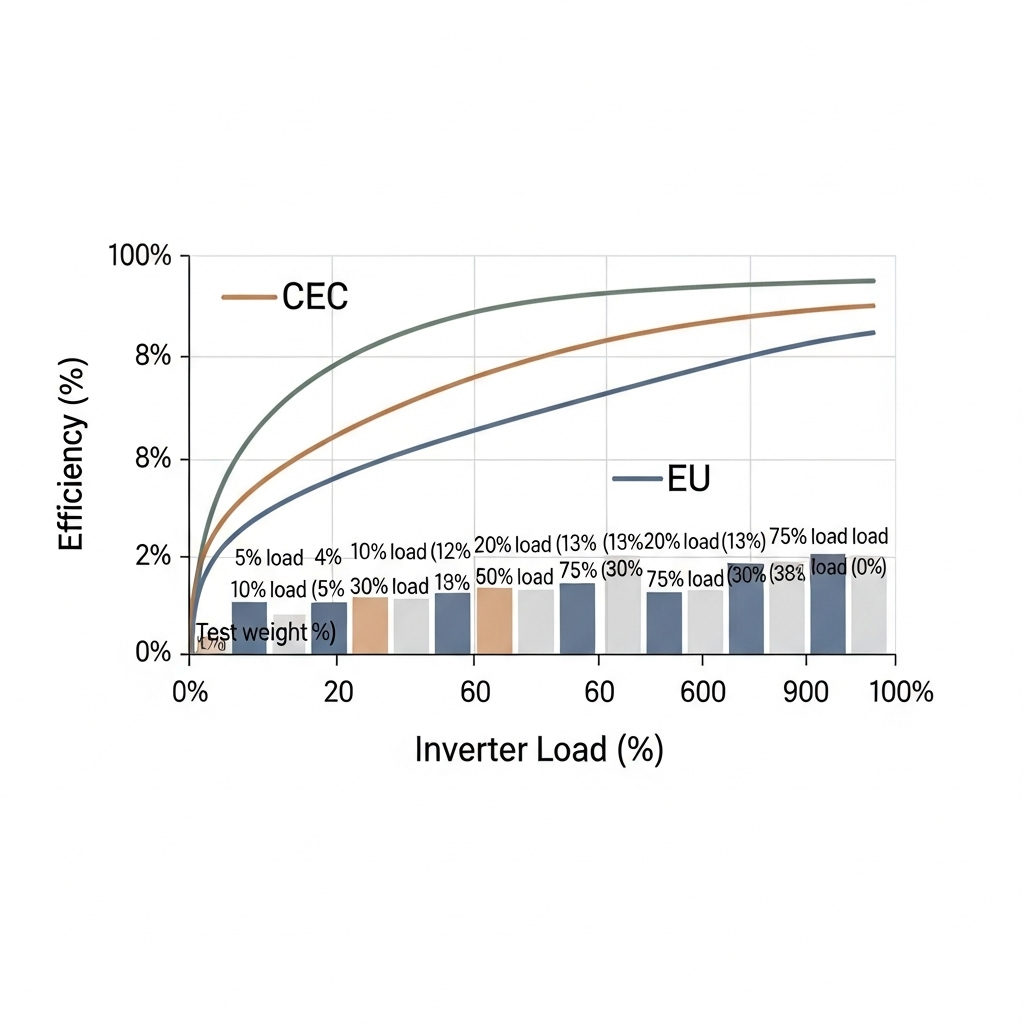Motors and HVAC compressors are the toughest loads in an off‑grid system. They pull a short, heavy burst of current at start‑up. If your Off-Grid Inverter cannot supply that surge, lights flicker, breakers trip, and compressors short-cycle. This piece gives practical math, tables, and a step‑by‑step path to right-size Inverter Surge Capacity for Motor Surge Sizing and HVAC Surge Sizing—without overspending.

Why surge capacity makes or breaks off-grid systems
Induction motors, scroll compressors, and even refrigerator compressors can demand 4–8 times their running current for 100–800 milliseconds until they reach speed. Across-the-line starts are the harshest; soft-starters and variable frequency drives (VFDs) can trim that spike but bring their own trade‑offs. The inverter must supply enough apparent power (kVA), not just watts, for long enough to ride through acceleration.
In mini-grids and remote systems, grid-forming inverters have shown robust behavior handling dynamic loads and even restoration events. According to Grid Codes for Renewable Powered Systems, grid-forming capability is already proven in mini-grids and enables services once provided only by synchronous machines. A recent field validation from the U.S. Department of Energy shows 24 grid‑forming inverters coordinating to blackstart and resynchronize multiple microgrids (Success Story—Using Renewable Microgrids to Keep the Lights On).
On the DC side, stable voltage under surge matters. Module‑level electronics and smarter wiring can help hold bus voltage under dynamic conditions; see the EERE Success Story on parallel wiring and vBoost, which highlights higher effective DC voltage with reduced resistive losses.
Storage is the backbone for surge delivery. Public analyses point to sharp growth in battery capacity to support variable loads and PV (Energy.gov Solar Energy). The IRENA Electricity Storage Valuation Framework also frames how short bursts of capacity add outsized reliability value in distributed systems.
Motor and HVAC surge math you can use
Key formulas
- Single‑phase starting kVA ≈ (Supply volts × LRA) ÷ 1000.
- Three‑phase starting kVA ≈ (√3 × Line volts × LRA) ÷ 1000.
- Required inverter surge kVA ≥ Starting kVA × margin (typically 1.2–1.5 for wiring, temperature, and variability).
- Check surge duration: motor start time must be shorter than the inverter’s surge window.
Rules of thumb by device
- Small induction motors (fans, small pumps): start current ≈ 3–5× running.
- Deep‑well pumps, piston air compressors: start current ≈ 5–8× running.
- Scroll AC/heat pump compressors: LRA on nameplate; commonly 40–120 A at 240 V for 1–5 ton units.
- Inverter‑driven mini‑splits (variable speed): 1.2–2× running inrush if properly programmed.
Worked examples
Example A — 1 HP deep‑well pump, 120 V, nameplate LRA 45 A. Starting kVA = 120 × 45 ÷ 1000 = 5.4 kVA. With 25% margin: 6.8 kVA. Choose an Off-Grid Inverter with ≥7 kVA surge for ≥1 s. On 48 V DC, surge current ≈ 7000 W ÷ 48 V = 146 A (plus inverter losses). Ensure the battery BMS and cabling can deliver ≥160 A for 1 s.
Example B — 2‑ton scroll heat pump, 240 V, LRA 70 A. Starting kVA = 240 × 70 ÷ 1000 = 16.8 kVA. With 25% margin: 21 kVA. A soft‑starter that cuts LRA by 50% lowers starting kVA to ~8.4 kVA; margin target ≈ 10–11 kVA. Without soft‑start, only higher‑capacity inverters with long surge windows will cope.
Typical surge needs and inverter suggestions
| Load | Rated power | Nameplate LRA | Supply | Starting kVA | Suggested inverter surge | Soft‑start impact |
|---|---|---|---|---|---|---|
| 1 HP deep‑well pump | ~1000 W | 45 A | 120 V | 5.4 kVA | ≥7 kVA for ≥1 s | 30–60% lower LRA |
| 2‑ton scroll AC/HP | ~2 kW | 70 A | 240 V | 16.8 kVA | ≥20 kVA (no soft‑start) or ≥10–12 kVA (with soft‑start) | 50–70% lower LRA typical |
| 1.5‑ton inverter mini‑split | ~1.2 kW | 15 A equiv. | 240 V | 3.6 kVA | ≥4–5 kVA | Usually not required |
| Refrigerator compressor | 200–300 W | 6–10 A | 120 V | 0.7–1.2 kVA | ≥1.5–2 kVA | N/A |
Values are indicative; always check the nameplate. Temperature, altitude, wiring, and state of charge affect real results.
Spec sheet decoding: kW vs kVA, surge window, power factor
- kW vs kVA: Motors are reactive during start. Size to apparent power (kVA) and to the inverter’s listed surge current, not only kW.
- Surge window: Common specs include 2× for 100 ms, 2× for 1 s, 1.6× for 10 s. Match the window to the motor’s acceleration time.
- Overload ratings: Look for motor/start or “inductive” mode ratings. Continuous overload (e.g., 110% for 10 min) is a different metric than instantaneous surge.
- Power factor: At start, PF can drop below 0.3. That inflates kVA relative to kW.
- Thermal limits: High ambient reduces surge headroom. Derate per the manual.
| Inverter surge spec (generic) | Duration | Best suited for | Notes |
|---|---|---|---|
| 3× for 20–100 ms | Very short | Fans, small tools | Not ideal for deep‑well pumps |
| 2× for 1 s | Short | Pumps, fridges | Fits many residential motors |
| 1.6× for 10 s | Long | Heavy rotors | Check continuous thermal margin |
Battery and DC-side constraints
Inverter Sizing for Motors and Inverter Sizing for HVAC must respect the battery, busbars, and BMS limits. LiFePO4 packs typically sustain higher peak currents than lead‑acid at the same capacity, with less voltage sag. Still, the BMS sets a hard ceiling. Keep surge current below the BMS pulse rating and cable ampacity with a 10–20% buffer.
- Quick check: Surge DC current (A) ≈ (Surge watts ÷ DC bus volts) ÷ inverter efficiency. Add margin for cabling and cold temperatures.
- C‑rate: A 48 V, 100 Ah pack has 4.8 kWh. At a 2C pulse, that is ~200 A capability for a few seconds. Verify the specific BMS.
- PV array match: A slightly larger array can help keep the DC bus healthy during daytime motor starts by holding voltage. For system‑level context on solar, storage, and flexibility needs, see the U.S. Energy.gov Solar Energy overview.
A practical reference that compiles performance drivers across batteries, inverters, and PV is this resource: Ultimate Reference: Solar Storage Performance. It highlights how state of charge, temperature, and inverter behavior shape delivered power—useful inputs when validating surge headroom.
Start methods and their impact
| Start method | LRA reduction | Start torque | Notes |
|---|---|---|---|
| Across-the-line (DOL) | None | High | Highest surge; simple hardware |
| Soft‑starter | ~30–60% | Moderate | Lowers peak current; keep start time within inverter window |
| VFD | ~60–80% | Controlled | Excellent reduction; adds harmonics; usually needs 3‑phase motor |
Step‑by‑step sizing workflow
- List all motor loads. Capture running watts, nameplate LRA, supply voltage, and likely concurrency.
- Convert LRA to starting kVA. Add 20–50% margin for variability and wiring.
- Decide diversity. Avoid stacking worst‑case starts. Sequence large loads or add soft‑starters.
- Select an Off-Grid Inverter with surge kVA and duration that exceed the largest single starting event, plus concurrency margin.
- Check battery surge current and BMS pulse rating. Confirm cable ampacity and voltage drop.
- Plan array size so daily energy needs are met while keeping the battery SOC in the healthy band that supports surge. This aligns with the theme of matching inverter power to array size.
- Commission in stages. Log inverter events. Tune soft‑starter ramp time or VFD acceleration as needed.
Case snapshot: farmstead water + heat
Loads: 1.5 HP 240 V deep‑well pump (assume LRA 55 A) and a 2‑ton heat pump (LRA 70 A). Worst single start is the heat pump at 16.8 kVA. With 25% margin: ~21 kVA. Add a soft‑starter to the heat pump targeting 50% LRA reduction; new target ≈ 10.5 kVA. Pick an inverter with ≥12 kVA surge for ≥1 s. Battery: 48 V 200 Ah LiFePO4. Surge DC current for 12 kW ≈ 12,000 ÷ (48 × 0.92) ≈ 272 A; confirm BMS and cabling. Sequence starts to avoid simultaneous inrush.
Why this matters for reliability
Real grids show that advanced inverters can sustain reliable service through disturbances. Trials summarized by IRENA and field demonstrations from Energy.gov indicate that stronger inverter controls, storage, and smart coordination keep critical loads powered. As HVAC electrification grows—see broad sector trends tracked by the IEA and EIA—right‑sizing surge headroom is a simple way to prevent nuisance trips and protect compressors.
FAQ
How do I size an inverter for a well pump?
Read the nameplate LRA and voltage, compute starting kVA, then pick an inverter with at least 20–50% extra surge capacity for at least 1 second. If you cannot meet that with budget or space, add a soft‑starter and retest.
Do soft‑starters or VFDs always solve surge issues?
They reduce LRA but extend start time. Ensure the inverter’s surge window is long enough. VFDs are best with 3‑phase motors and need proper filtering to limit harmonics.
How do I account for multiple motors starting?
Add diversity. Stagger starts. Size for the largest single surge plus a realistic concurrency factor (often 1.2–1.3) rather than stacking worst cases that rarely occur together.
What about kW vs kVA on spec sheets?
Use kVA for surge sizing. Motors at start have low power factor, so apparent power is higher than watts. Pick the inverter by surge kVA and duration.
How do batteries limit surge?
The BMS sets a maximum pulse current. Voltage sag increases at low state of charge and cold temperatures. Verify pulse ratings and keep cables short and appropriately sized.
References and further reading
- Grid Codes for Renewable Powered Systems (IRENA)
- Electricity Storage Valuation Framework (IRENA)
- Success Story—Using Renewable Microgrids to Keep the Lights On (DOE)
- New Converter and Wiring Setup Can Improve PV Module Performance (DOE)
- Solar Energy topics overview (DOE)
- International Energy Agency – sector trends
- U.S. Energy Information Administration – data and analysis
- Ultimate Reference: Solar Storage Performance
Technical disclaimer: Sizing values are typical estimates. Always confirm with equipment manuals and local electrical codes.





Leave a comment
All comments are moderated before being published.
This site is protected by hCaptcha and the hCaptcha Privacy Policy and Terms of Service apply.